Are you looking for some of the world’s most beautiful brown birds? If so, you’re in the right place, as we’ve prepared a list of 11 species with unique brown plumages! We will not only tell you about their colors but also discuss the birds’ distribution, diet, breeding behavior, and migration during winter!
11 Brown Bird Species
1. Scaly-Breasted Munia
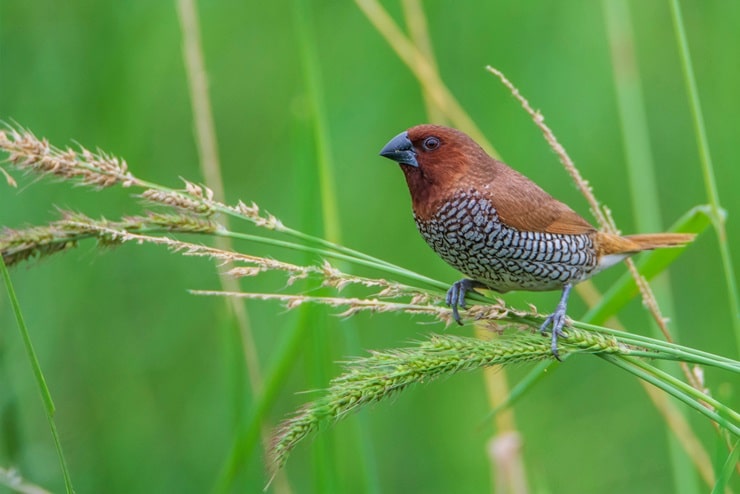
- Scientific name: Lonchura punctulata
- Size: 4.3 – 4.7 inches
- Weight: 0.026 – 0.035 pounds
- Wingspan: 8 – 10 inches
A scaly-breasted munia’s plumage features different shades of brown. The underparts are white and feature dark scale markings. Its head is typically dark brown. Male and female birds usually look similar, although one thing can help you distinguish them: the throat and the markings on the underside are darker in males. Scaly-breasted munias do not migrate.
Scaly-breasted munias are endemic to Asia, where they live in various habitats, although they generally prefer those close to water sources.
These birds eat small berries, insects, and grass seeds but can occasionally delight in algae, especially right before the breeding season, typically between June and August. Their nests are made from bamboo, blades of grass, or other leaves the birds can find and arranged in a large domed structure with a side entrance. Most often, these are located in trees.
2. Lapland Longspur

- Scientific name: Calcarius lapponicus
- Size: 5.9 – 6.3 inches
- Weight: 0.8 – 1.2 ounces
- Wingspan: 8.7 – 11.4 inches
While their plumage isn’t fully brown, Lapland longspur birds have a chestnut nape and brownish shades on the wings. Some have black heads and throats; others have orange-brownish heads. The underparts and the eyestripes are typically white.
These birds are found in the Northern Hemisphere, across Arctic Europe, the Palearctic, Canada, and the northern United States. During winter, these birds fly to the southern United States, Russian steppes, or Northern Scandinavian arctic regions.
They generally eat arthropods during summer and seeds during winter. However, they sometimes mix the two – scientists believe these birds can eat 10,000 seeds and 3,000 insects a day!
Lapland longspurs breed in wet areas or bare mountains and build their nests on the ground.
3. House Sparrow
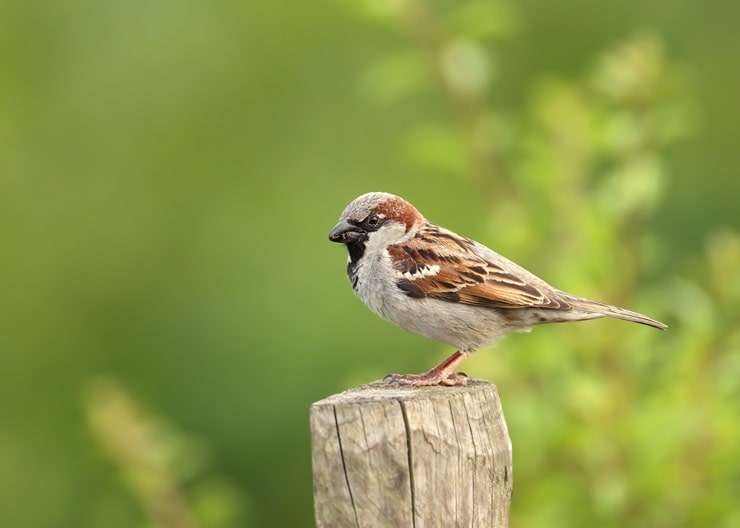
- Scientific name: Passer domesticus
- Size: 5.5 – 7.1 inches
- Weight: 0.85 – 1.39 ounces
- Wingspan: 7.5 – 9.8 inches
We’re almost sure you’ve seen a house sparrow at least once, as they are spread around the world, living close to urban and rural areas.
Their plumage is primarily brownish-gray and has a unique pattern. Males have chestnut brown parts on both sides of their heads and brown parts on their backs. Females are primarily brown, both on the head and underparts. Males’ bills are black, while females have grayish-brown bills.
Adult birds eat grain or weed seeds but can adapt to other foods. Their breeding behavior depends on their age and distribution, but they generally attempt to breed right after hatching. As they grow older, though, house sparrows have higher reproductive success. These birds prefer building nests in house crevices, tree hollows, or cliff holes.
Most adult birds do not migrate or even move more than a few miles throughout their lives, although this depends on where they live and how old they are. For instance, mountain house sparrows move to lower elevations when temperatures drop.
4. Bell’s Sparrow
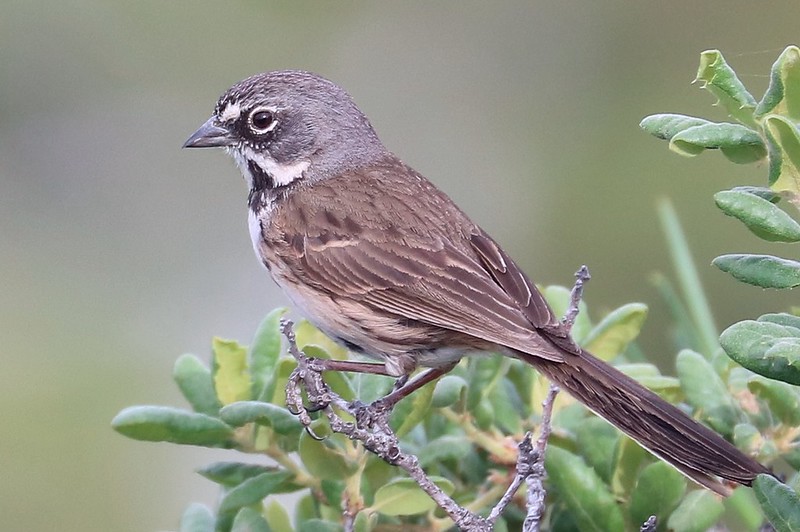
- Scientific name: Artemisiospiza belli
- Size: 6 inches
- Weight: 0.58 ounces
- Wingspan: 8.21 inches
Adult bell’s sparrows have distinctive patterned colorations. Juveniles, on the other hand, are uniformly brown. The adult bird has a grayish head and brownish, darker body. The underparts are of a lighter shade, while the tails are dark, almost black.
Bell’s sparrows live in northwestern Mexico and the western United States. They’re found in sagebrush habitats, where they can easily use their plumage coloration for camouflage! In their natural habitat, bell’s sparrows forage on the ground and feed on seeds, insects, weeds, and grasses.
These birds typically nest in low shrubs or directly on the ground near a shrub. Their nests are made of sticks, twigs, dry grass, and animal hair if they find some. Bell’s sparrows breed in south-central California and rarely leave their breeding site. Only the specimens living in the Sierra Nevada sometimes migrate to Arizona during winter.
5. Cedar Waxwing

- Scientific name: Bombycilla cedrorum
- Size: 6 – 7 inches
- Weight: 1.1 ounces
- Wingspan: 8.7 – 11.8 inches
The cedar waxwing has a unique appearance! These birds have distinctive shiny plumage, which can help you distinguish them from other birds. The plumage is a combination between brown, gray, bright yellow, black, and red. Moreover, these birds have a black “mask” on their faces, bright red spots on the wing feathers, and brown-grayish bodies with bright yellow underparts. Males and females look similar.
These birds are found in Central and North America, breeding in Canada and wintering in the United States, sometimes in South America. They live on the trees found around wooded areas. Cedar waxwings are often spotted in urban and suburban areas in golf courses, parks, and cemeteries.
These birds primarily eat berries and fruits rich in sugar. Sometimes they catch and feed on insects, too. Their breeding season starts in May and lasts until late summer. The nest is built in around six days – they consist of twigs and grasses and have the form of a loose open cup.
6. Gray-Cheeked Thrush
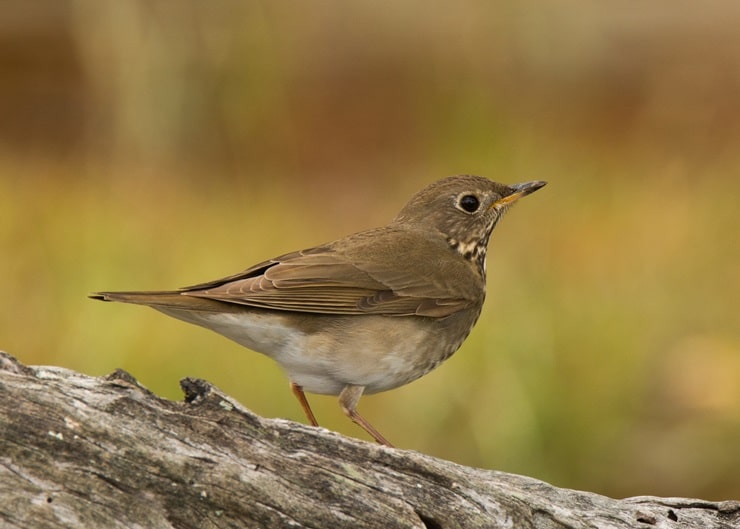
- Scientific name: Catharus minimus
- Size: 5.9 – 6.7 inches
- Weight: 0.9 – 1.05 ounces
- Wingspan: 12.6 – 13.4 inches
This gray-cheeked thrush resembles many of the birds on our list, primarily thanks to the dark brown, almost black spots on its pale underparts. The gray-cheeked thrush has a gray face, a brown upper side with grayish shades, and dusky flanks. The head is brown, too, except for the part between the eyes and the beak, which is gray. While these are standard colorations, they may vary depending on the subspecies.
If you’re trying to spot this bird, we recommend visiting the Amazon basin during winter and the northern boreal forests in North America during the breeding season, as they’re long-distance migratory birds. In their natural habitats, gray-cheeked thrushes feed primarily on insects but can sometimes eat fruits, berries, earthworms, and crayfish.
During the breeding season, females build their nests using dried grasses and mud in low shrubs or on the ground. They generally produce one brood per season.
7. Rustic Bunting
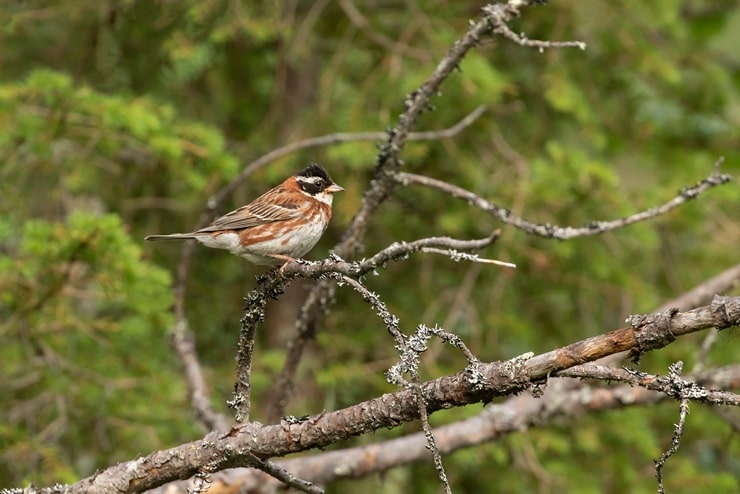
- Scientific name: Emberiza rustica
- Size: 5.1 – 5.7 inches
- Weight: 0.58 – 0.8 ounces
- Wingspan: 9 inches
If you want to find a rustic bunting, look for a small bird with distinctive feathers on its head that resemble a spiky hairstyle! This passerine bird has pink legs, a reddish flank, white underparts, a pink lower mandible, and a black head. Its back is typically covered in brown plumage, having white spots on the wings.
Young males and females look similar, as they have paler colors, while summer males can be distinguished by the black-and-white head pattern and the reddish breast.
This bird is primarily found in Asia, Korea, China, Japan, and rarely in Europe. In its natural range, the rustic bunting lives and breeds in wet coniferous woodlands.
Adult rustic buntings feed on seeds, while their young eat insects. They typically breed from Scandinavia to northern Siberia, where they build their nests on the ground. During winter, rustic buntings migrate to China or Japan, rarely to North America’s Pacific Coast.
9. Carolina Wren
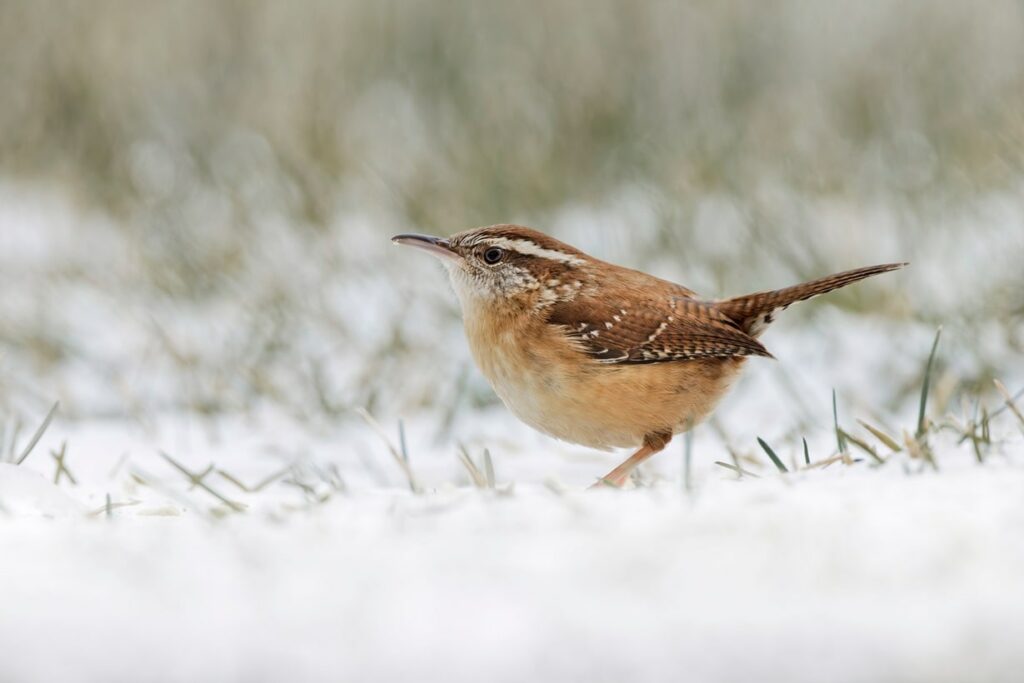
- Scientific name: Thryothorus ludovicianus
- Size: 4.9 – 5.5 inches
- Weight: 0.63 – 0.81 ounces
- Wingspan: 11 inches
It is, in fact, South Carolina’s state bird!
A Carolina wren has a distinctive, erect tail that can help you distinguish it from other birds! The bird has light underparts with shades of light brown and white. The head is grayish-brown-reddish, except for its sides, which feature a white band extending from the eyes to the back of the head. The back and the tail are orange-brownish.
Moreover, the wings have lighter, pale, almost grayish brown shades. In August and September, the plumage becomes darker in post-juvenile Carolina wrens. Male birds are larger and 11% heavier than females.
Carolina wrens can be found in the eastern United States in mixed oak-pine woodlands, hickory-oak woodlands, and oak hardwoods, where they feed on invertebrates, lizards, tree frogs, fruit pulp, and seeds. They are considered resident birds.
These birds usually mate for life and nest in arch-shaped structures that are made of strips of bark, dry plants, horsehair, and strings. Males and females work together in building the nest, which is usually located in tree cavities, bird boxes, mailboxes, or buildings.
9. Spotted Sandpiper

- Scientific name: Ascites macularius
- Size: 7.1 – 7.9 inches
- Weight: 1.2 – 1.8 ounces
- Wingspan: 14.6 – 15.8 inches
Besides its uniquely patterned plumage, the spotted sandpiper has longer legs than other birds, although it’s not a large bird. Its legs are yellowish, while the bills are orange overall, featuring a black tip.
The upper side of a spotted sandpiper’s body is brown, while the underparts are white and marked with black spots, which vary depending on the bird’s location and whether we’re discussing breeding or non-breeding plumage. For example, non-breeding birds do not have these black markings on the underparts. Males and females look similar, although the latter are heavier.
Spotted sandpipers can be observed near freshwater habitats. Their range covers the northern United States and Canada during the breeding season and the southern United States, South America, the Caribbean, and sometimes Europe during winter. These birds eat insects, invertebrates, and small fish.
These birds typically breed near water sources. Females arrive earlier at breeding grounds and often mate with more than one male, the “fathers” subsequently taking care of the offspring.
10. Pine Siskin
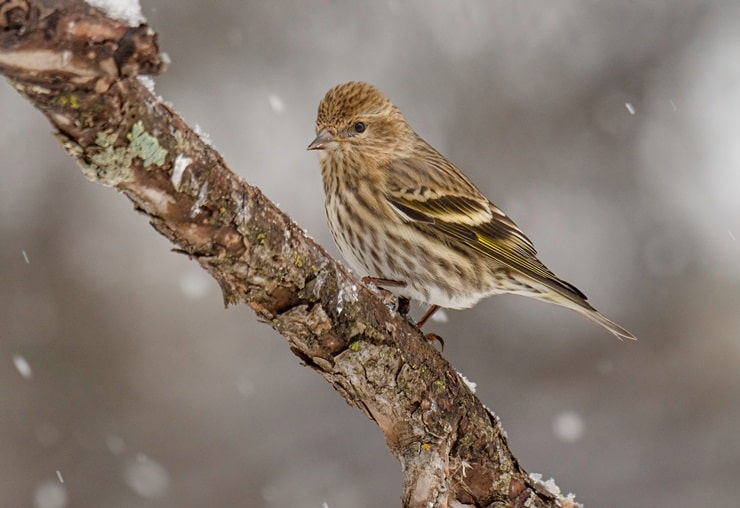
- Scientific name: Spinus pinus
- Size: 4.3 – 5.5 inches
- Weight: 0.42 – 0.63 ounces
- Wingspan: 7.1 – 8.7 inches
Adult pine siskins have brown upperparts and lighter, pale undersides. The tails are short and forked, while the bills are slender and elongated. Some specimens have yellowish-greenish shades on their wings. Males and females are typically similar, although female tails are much duller in color.
Pine siskins are endemic to North America and are found in Canada and the northern United States, where they live in open conifer forests. These are migratory birds, which fly south for the winter, although the period they migrate is highly variable.
These birds feed on seeds and plant parts, although they may sometimes eat insects, too. They usually feed in open forest canopies, but may occasionally forage in thickets, grasslands, roadside, and meadows. Breeding typically occurs in northern pine forests and the nests are built on horizontal tree branches, usually on conifers.
11. Brown Thrasher
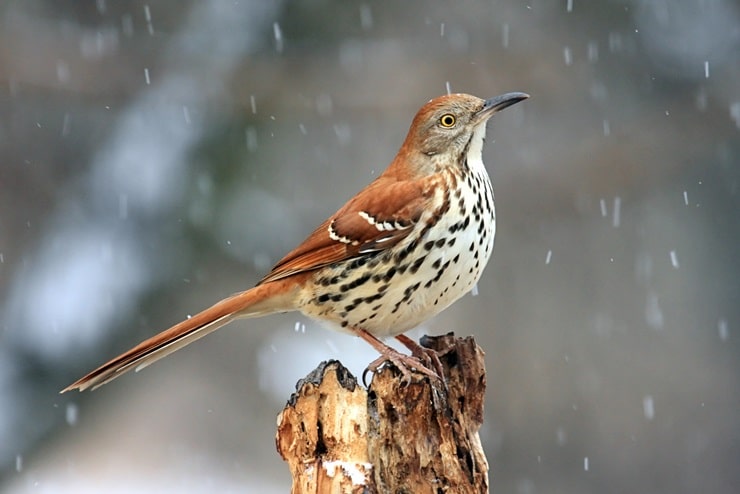
- Scientific name: Toxostoma rufum
- Size: 9.3 – 12 inches
- Weight: 2.2 – 3.1 ounces
- Wingspan: 11 – 13 inches
Brown thrashers have brown upper parts and white chests with dark brown spots that look like teardrops. The bill is long and brown, while the eyes are typically bright yellow. The tail is brown but has pale corners. Males and females are usually similar.
During the breeding season, these brown birds are found in Canada and the United States, where they primarily occur east of the Rocky Mountains. Brown thrashers are partial migrants, as only the birds living in northern and central regions migrate.
Brown thrashers are omnivorous birds and feed on insects, earthworms, snails, berries, seeds, and nuts. The breeding season depends on where the birds live. For instance, the breeding season for those living in the southern United States starts in February – March. In the north, on the other hand, it starts in May – June. Both males and females participate in building the nest, which is usually found in dense shrubs or low in trees. Sometimes the nests are built on the ground.
Discover Other Colored Birds:
Red Birds
Green Birds
Purple Birds
